
The privatisation of public land in neoliberalism Britain


With the arrival of Margaret Thatcher in Downing Street in 1979 a major privatisation drive began not only selling industrial holdings, transport infrastructure, the telephone system but also the land and public buildings erected on it. Land makes a major chunk of national wealth and an estimate by the Office for National Statistics concluded that out of total national wealth of £9.8tn, land accounted for £5tn and houses and other added another £3.5tn.
Of all the land in Britain, public agencies owned 20 per cent, and 60 per cent was in the hands of private individuals.
The New Enclosure is about the transfer into private ownership of roughly half of the public estate that was by far the largest element of Britain’s privatisation programme.
The disposal of land and buildings, council homes, military facilities, NHS land and school playing fields transferred property yielded £400bn form the public and private sector. British taxpayers have been robbed blind the recent fire sale of 400 billion pounds of public land. Like Henry VIII’s destruction of monasteries, Thatcher’s privatisation frenzy has led to the destruction of public assets unprecedented amongst leading economies, and to the enrichment of landowners and financiers.
How did the land become so invisible as part of the privatisation story? Beginning in earnest is the 1500s, the wave of enclosures fencing in land previously used for common grazing supercharged development of agrarian capitalism. Free trade politics, spearheaded by the call for the abolition of the corn laws, was anti-landlord politics. In the 19th century Britain’s ruling elite owned land, but the state itself did not. In the 20th century, Local councils bought land to build public housing or affordable housing to relocate slum dwellers.
After the first world war, the Forestry Commission recognised the need to secure timber supplies, In the second world war, Britain was turned into a giant army camp, the countryside was studded with airfields. Postwar public housing brought huge swaths of urban land into public ownership.
In 1950s and 1960s critics carped that government was hoarding land. In the 1970s public ownership reached its peak and also its moment of crisis.
Private land owners are slower to develop their land portfolios. Thatcher’s victory put the critics of public ownership in power, and Whitehall was converted to a policy of sale at any price.
In 1979 42 per cent of the UK’s population lived in council housing and sadly today the figure is less than 8 per cent.
The privatisation would energise land use. It is no doubt that property developers benefited enormously from privatisation. Those developers are big donors to the UK’s Conservative Party, the major advocate of privatisation. Parliament is full of landowners, great and small and profiteering by a new class of private and corporate landowners is one likely explanation for the privatisation drive.
His meticulously researched study, has made essential contribution to our understanding of politics and government in modern Britain.
The New Enclosure: The Appropriation of Public Land in Neoliberal Britain by Brett Christophers Verso £20/ $ 29.99, 304 pages.
